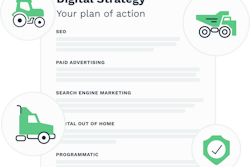The past few years have been a whirlwind for the commercial truck dealership industry. With the unprecedented challenges brought by the COVID-19 pandemic, the subsequent sales boom and the return to a more predictable market, many dealership owners are asking themselves: Where does my business stand now?
More importantly, how can I set it up for long-term success, whether I plan to continue operations or prepare for a future sale?
This article will guide you through the essential steps to assess past performance, identify your dealership’s steady-state business level and chart a course for sustainable growth.
Evaluating performance over the past few years
The first step in preparing your dealership for the future is to pause and take an honest look at past performance. Analyzing financial records, sales data and operational efficiency from 2020 to 2024 provides critical insights.
Revenue trends:
- Identify peaks and valleys in sales revenue.
- Determine whether revenue growth has been consistent or erratic.
- Compare sales data before and after the COVID-driven market surge.
Profit margins:
- Assess fluctuations in profit margins over time.
- Analyze the impact of inventory shortages, increased vehicle prices, excess inventory and shifting consumer demand.
- Identify key cost drivers and explore opportunities to optimize expenses.
Operational efficiency:
- Review productivity metrics, such as sales per employee or service department output.
- Determine if staffing levels align with business needs.
- Examine marketing effectiveness and customer acquisition costs.
Finding your steady-state business level
While the past few years may have seen record highs (or unexpected lows), it is crucial to determine the true baseline of your dealership’s performance.
The steady-state business level is where your operations stabilize, absent of external disruptions. To find this:
Look beyond outliers:
- If 2021 and 2022 saw extraordinary sales due to market conditions, don’t assume those numbers represent normal business levels.
- Remove anomalies from your data to see what sustainable performance looks like.
Compare to pre-pandemic levels:
- Analyze 2018-2019 performance as a benchmark.
- Identify patterns that have remained consistent despite external disruptions.
Forecast realistic growth:
- Based on stable market conditions, project sales growth using conservative estimates.
- Set achievable revenue and profit goals for the next 3-5 years.
Assessing your role in the dealership's success
As a dealership owner, understanding your impact on the business is crucial. Are you the primary driver of success, or is your team empowered to operate efficiently without you?
Self-reflection on leadership:
- Are major sales decisions, customer relationships, and operational management dependent on you?
- Do employees have clear roles and responsibilities, or do they rely on you for guidance?
Management and delegation:
- Identify key managers and their level of autonomy.
- Develop training programs to build leadership skills within your team.
- If you were absent for an extended period, could the business continue running smoothly?
Succession planning:
- If selling is a future consideration, ensure that your dealership can thrive without your daily involvement.
- Build a strong second-in-command or consider hiring a general manager to reduce reliance on your leadership.
Setting the foundation for future growth
Once you have a clear understanding of where your dealership stands today, it’s time to set the stage for growth. Sustainable growth is not about chasing peak pandemic sales numbers but building a resilient, adaptable and profitable business.
We believe key areas to focus on include:
Customer retention and satisfaction:
- Strengthen relationships with existing customers through loyalty programs.
- Improve customer experience in both sales and service departments.
- Implement a proactive follow-up system to maintain engagement.
Market expansion and diversification:
- Explore new revenue streams such as fleet sales, leasing or electric vehicle adoption.
- Expand digital marketing strategies to reach new customer demographics.
Technology and efficiency improvements:
- Invest in dealership management software to streamline operations.
- Improve online sales and service booking systems.
- Utilize data analytics to make informed business decisions.
Conclusion
Taking the time to pause and reflect on your dealership’s performance is an essential first step in preparing for the future. Whether your goal is continued growth or eventual sale, understanding your steady-state business level, assessing your leadership’s role and setting strategic growth plans will position your dealership for long-term success.
By implementing the insights and strategies outlined above, you will not only gain a clearer vision of your dealership’s current standing but also create a roadmap for a prosperous future.











